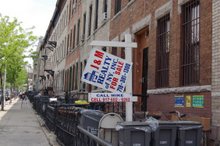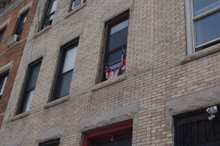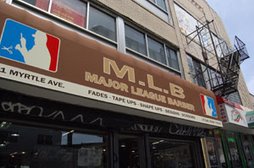Throughout its history, Bushwick has become the place with a question of ownership; the Native Americans fought over it with the Dutch and today, the community of Bushwick is fighting a war of race and money, as living there becomes a commodity and a right.
"Bushwick is known as a "ghetto community" but now that The New York Times is promoting it as the "New Manhattan," it's become a trend to come here and make a home for yourself," Jose Lopez, the community organizer of "Make the Road by Walking," says.
"Make the Road by Walking" is a youth organization working to prevent gentrification, promote education and economic justice, creating a new breed of young individuals and current residents who draft coalitions to save what they say is their home.
This "little town in the woods," as the Dutch called it, has a population that is 91 percent African-American and Hispanic and a staggering 45 percent under the age of 25, according to the 2000 census. Walking through the neighborhoods of Bushwick, it's easy to forget that these people are living in
However, Bushwick faces many problems.
As of 2005, 28.3 percent of the population has suffered severe poverty and unsafe living conditions. Because of the rise in the cost of living, landlords, real estate agents and entrepreneurs have increased their rent. Poor families and minorities have especially been affected, as virtually all of Bushwick is African-American and Hispanic. Low-income families are displaced from their homes because they can no longer afford to pay the rent and are forced to with other poor families in crowded and unhealthy living conditions of one-family apartments.
Maria Quitanilla, an immigrant from
"I came to the
But today, Quitanilla is facing another fear, the fear of being kicked out of her apartment, a place she has called home for 14 years. Quitanilla, 49, lives with two children and her older cousin in a two-bedroom apartment on
Quitanilla is working with "Make the Road by Walking" to improve housing conditions in Bushwick and to solve the problems she has recently had with her landlord.
"One time the toilet was broken, and he [the landlord] didn't want to fix it and told me I should be used to it because I live like this in my country," Quitanilla says.
In another instance, Quitanilla says she had bed bugs in her apartment and asked the landlord to hire an exterminator to remove the bugs. But she says her landlord told her not to come to him with her problems anymore, and he said a way to remove the bed bugs is to put a tortilla on the floor, and the bed bugs will come out and eat it.
As an undocumented immigrant, Quitanilla has no credit history and because of this, she finds it difficult to get approved for another apartment.
"I have the right to live here. I've been here for 14 years, and this is my home. I can't afford to live in apartments $900 to $1,000 a month," Quitanilla says. "It's nice that development in Bushwick is happening, but it's adding to my problem. Even if I do save enough to live in a 900 dollar apartment, it's not enough to put food on the table."
But just two years ago, Bushwick has become a town of lower crime rates, lofty apartments, penthouses and pricey art, music and clothing boutiques. A newly built apartment building of chic architecture with ocean blue glass windows and silver steel stands in the middle of town, apart from the chipped white paint of a family house nearby. The cheapest room is $250,000 a month.
"You know when you stop buying your morning coffee at a Mexican bakery and start drinking at a newly built Starbucks down the street, you're fucked," Lopez says. "We don't welcome those shops here because they don't cater to our community. We don't need organic food shops, rock n' roll music stores and expensive designer clothes because we can't afford it."
The community of Bushwick is fighting with more than just the issue wealth, though. As half of the battle becomes one of race and politics. Lopez says signs of gentrification started to show as an influx of White, educated and wealthier people have moved into brownstones and have taken over the new developments and projects that the community has worked on to improve the town.
Lopez says, "We want to keep the flavor of Bushwick. We do want a safer neighborhood but at the same time, we want to have the same opportunities that the white kids are getting. You really can't separate race with class, and as you know a lot of minorities get the shitty schools and kids drop out, and we're all stuck in a cycle of poverty."
But gentrification in Bushwick has caused more than just an uproar in the community, it has created movements. In a vacuum of ideas and culture that is
While some people are opposed to gentrification, others welcome it.
Young artists, newly graduated college students and people in their 20s have become the new gentrifiers, making Brooklyn what they say a "bohemian" version of
Brianne McCabe, a student at CUNY Baruch, lives in
“Many new apartment buildings like condos and lofts are being built. Gentrification cannot be stopped. Cities and areas will continue to be gentrified as long as people are willing to buy,” McCabe says. “So many artists and freelancers who have little income come live in these areas, including students like me.”
James Orlando, a design and management student at Parsons School of Design in
Currently living in midtown
"I don't think gentrification is necessarily a bad thing. I mean, they're developing areas which isn't bad because they're trying to improve the quality of life there. It sucks for people living there to be displaced, but if you look at people like me, Bushwick is creating a community for young artists,"
Sean Elder, a freelance writer and editor, is an activist of "Develop, Don't Destroy Brooklyn." He lives in
"It is hard to separate issues of race and class in
"Develop, Don't Destroy Brooklyn" is a community coalition that promotes diversity in
As part of the advisory board of "Develop, Don't Destroy Brooklyn," Elder has contributed money to the coalition and has worked with other high-profile writers in Brooklyn, like Jonathan Lethem and Jennifer Egan, in producing the coalition's newsletter.
"And the fringe benefits of gentrification — more restaurants, places to shop, less crime etc. -- are race blind. When we moved here eight years ago, a lot of my black neighbors were very happily taking the bars off their windows for the first time in over 30 years."
One of its recent projects includes opposing the "Atlantic Yards Project" led by Forest City Ratner, a local developer who plans on using seven acres of land to build affordable housing, commercial offices, retail establishments and a boutique hotel in downtown
"I think that a number of people who support the Atlantic Yards project thinking it will supply them with affordable housing in an increasingly attractive neighborhood are black — but would look at this neighborhood as too “gentrified” already. So the lines are not always clear but I can tell you that the people opposed to Ratner are black, white, brown, Asian...," Elder says.
Ratner says that building new establishments will give people more homes, jobs and resources, but they will also become a home for the NBA's Brooklyn Nets.
Nonetheless, Elder supports the young artists and students who come to live in
"Because of them [some come for Pratt Institute nearby, some just think this is the new
While gentrification is becoming more of a big issue nationwide, people say there are no ways to solve it.
"You can't reproduce land," Lopez says. "For people who are looking to move to Bushwick, just know where you're getting into. Leisure is different from moving. Folks that live here have different reasons. We count on our neighbors, so be aware of what you're coming here for."
Elder says gentrification is a slippery term. In some instances, gentrification can be good or bad, but it doesn't have to be a problem, though.
"It's a struggle that goes on case by case, neighborhood, by neighborhood, and it's up to the people who live there to engage with it."



















No comments:
Post a Comment